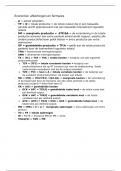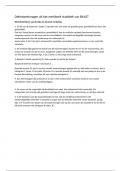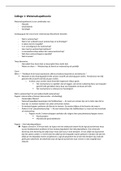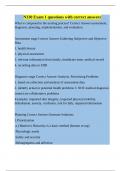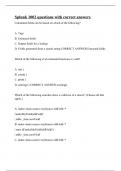Qualitative and quantitative determination of ethanol in an
alcoholic zinc lotion FNA based on headspace gas chromatography.
Tymo Zwakenberg
S4326253
Date of experiment: October 4, 2022
Date of submission: October 6, 2022
Aniek Barbier
1
,Table of contents
Introduction and theory 3
Materials and methods 4
Results and discussion 6
Conclusion 10
References 11
Appendices 12
2
, Introduction and theory
Chromatography is based on the continuous distribution of a particular substance across a stationary
and mobile phase where the two phases are not supposed to mix. This results in a physical
separation [7]. In this experiment headspace gas chromatography (HS-GC) is used as the analytical
method. HS-GC is commonly used to determine blood alcohol, residual solvents in pharmaceuticals
and flavors in food. HS-GC relies on the same principle as HPLC of molecules flowing, although
differences in characteristics determine their prefered way of usage. HS-GC has a liquid stationary
phase and a gaseous mobile phase, whereas HPLC has a solid stationary phase and a liquid mobile
phase. HS-GC can be used to determine volatile compounds in solid and liquid samples. The analyzed
compounds in this experiment are considered to be volatile because of there relatively low boiling
points (ethanol 78.2 °C, methanol 64.7 °C and acetone 56 °C [3]), therefore HS-HC is considered to
be the right analytical method. With HS-GC the volatile compounds are transfered into the column,
while the nonvolatile compounds remain in the headspace vial. Therefore, HS-GC is prefered over
normal gas chromatography in this instance [2]. In order to get a better understanding, a schematic
overview of the used setup during the experiment can be seen in figure 1.
Figure 1: Schematic overview of the HS-HC setup [6].
As stated, the boiling points of the analyzed compounds are of great interest, it is expected that the
boiling points correlate with the order of detection of the compounds, as represented in the
chromatograms. It is expected that acetone will be detected first because of its lowest boiling point,
which means it will evaporate the fastest and therefore can be detected the fastest, followed by
methanol and ethanol in the stated order. The underlying separation of compounds can be
represented in the following equation:
𝐶𝑙
K = 𝐶𝑔
K represents the partition coefficient, 𝐶𝑙 is the concentration in the stationary liquid phase and
𝐶𝑔 is the concentration in the mobile gaseous phase. It can be reasoned that the partition
coefficient will be lower if the temperature rises, since an increase in temperature will overcome the
boiling point easier, resulting in an increase in 𝐶𝑔 thus lower K [4]. Therefore it is expected that
analytes with a high partition coefficient mainly remain in the liquid phase and analytes with a low
partition coefficient mainly in the gaseous phase. Furthermore the separation depends on the
selectivity and efficiency of the process which is represented in the following equations [5]:
3
alcoholic zinc lotion FNA based on headspace gas chromatography.
Tymo Zwakenberg
S4326253
Date of experiment: October 4, 2022
Date of submission: October 6, 2022
Aniek Barbier
1
,Table of contents
Introduction and theory 3
Materials and methods 4
Results and discussion 6
Conclusion 10
References 11
Appendices 12
2
, Introduction and theory
Chromatography is based on the continuous distribution of a particular substance across a stationary
and mobile phase where the two phases are not supposed to mix. This results in a physical
separation [7]. In this experiment headspace gas chromatography (HS-GC) is used as the analytical
method. HS-GC is commonly used to determine blood alcohol, residual solvents in pharmaceuticals
and flavors in food. HS-GC relies on the same principle as HPLC of molecules flowing, although
differences in characteristics determine their prefered way of usage. HS-GC has a liquid stationary
phase and a gaseous mobile phase, whereas HPLC has a solid stationary phase and a liquid mobile
phase. HS-GC can be used to determine volatile compounds in solid and liquid samples. The analyzed
compounds in this experiment are considered to be volatile because of there relatively low boiling
points (ethanol 78.2 °C, methanol 64.7 °C and acetone 56 °C [3]), therefore HS-HC is considered to
be the right analytical method. With HS-GC the volatile compounds are transfered into the column,
while the nonvolatile compounds remain in the headspace vial. Therefore, HS-GC is prefered over
normal gas chromatography in this instance [2]. In order to get a better understanding, a schematic
overview of the used setup during the experiment can be seen in figure 1.
Figure 1: Schematic overview of the HS-HC setup [6].
As stated, the boiling points of the analyzed compounds are of great interest, it is expected that the
boiling points correlate with the order of detection of the compounds, as represented in the
chromatograms. It is expected that acetone will be detected first because of its lowest boiling point,
which means it will evaporate the fastest and therefore can be detected the fastest, followed by
methanol and ethanol in the stated order. The underlying separation of compounds can be
represented in the following equation:
𝐶𝑙
K = 𝐶𝑔
K represents the partition coefficient, 𝐶𝑙 is the concentration in the stationary liquid phase and
𝐶𝑔 is the concentration in the mobile gaseous phase. It can be reasoned that the partition
coefficient will be lower if the temperature rises, since an increase in temperature will overcome the
boiling point easier, resulting in an increase in 𝐶𝑔 thus lower K [4]. Therefore it is expected that
analytes with a high partition coefficient mainly remain in the liquid phase and analytes with a low
partition coefficient mainly in the gaseous phase. Furthermore the separation depends on the
selectivity and efficiency of the process which is represented in the following equations [5]:
3

